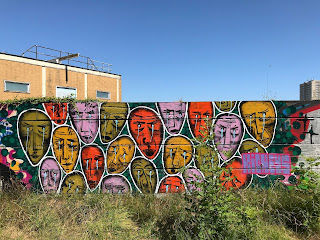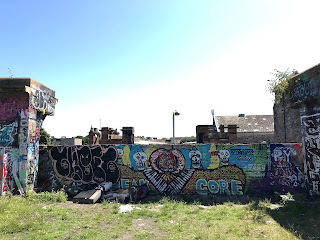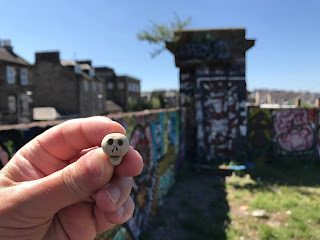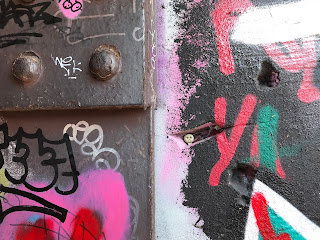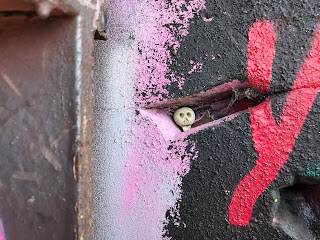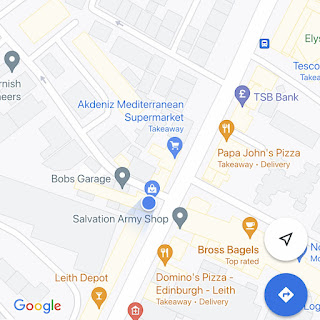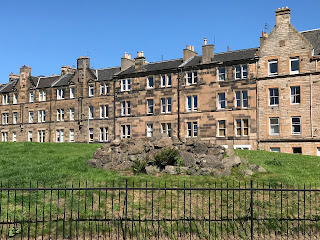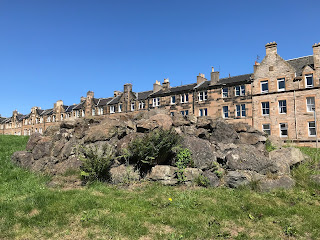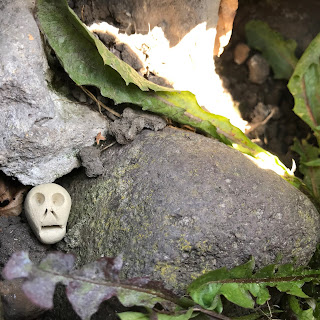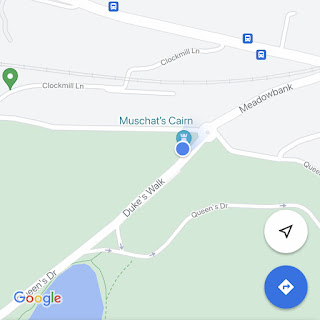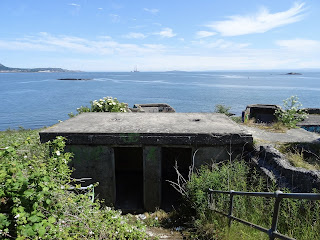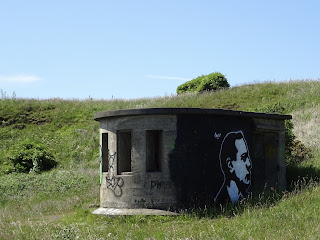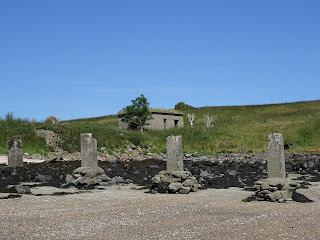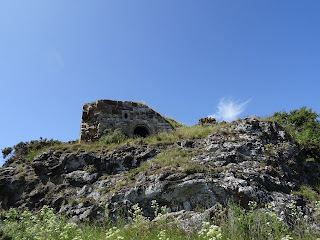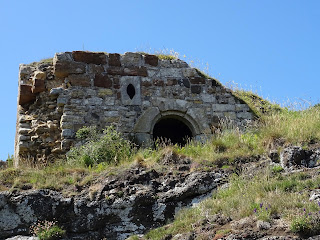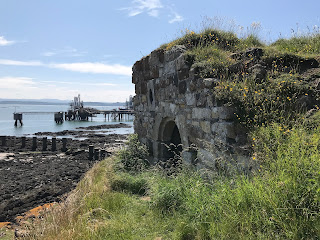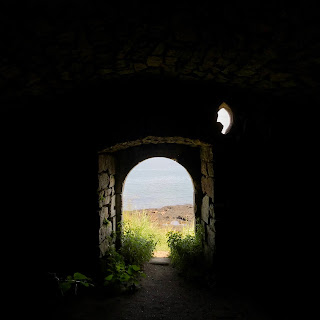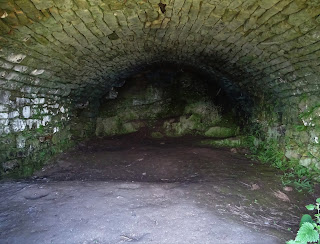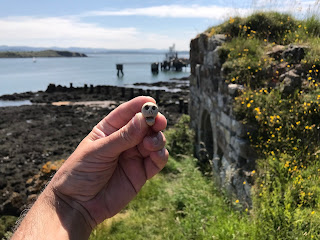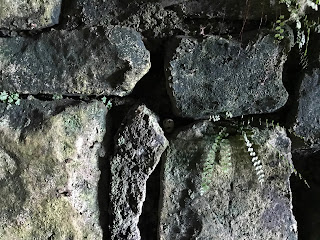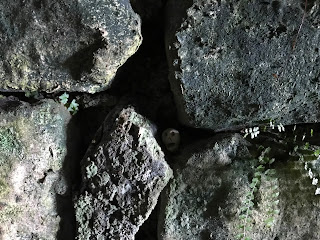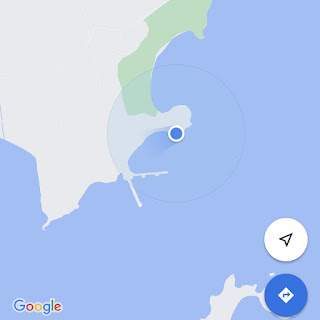If
you enter Holyrood Park from Meadowbank Terrace and walk a short way along
Duke’s Walk, you may notice a pile of rocks that appear to have been
abandoned. However, on closer
examination you will find that this is a low cairn, roughly cemented together. Like me, on first seeing it you may think
‘What the **** is that about?’ Well, it
turns out that it is a cairn laid in the memory of a victim of a horrible
murder that took place in the park in 1720.
Muschet’s
Cairn, on the gentle slope of a grassy mound in Holyrood Park
Muschet’s
Cairn in Holyrood Park
Muschet’s
Cairn by Duke’s Walk, Holyrood Park
One
of the main characters in the story behind the cairn is a rather pathetic
individual called Nicol Muschet. Nicol
was the eldest of several children and was brought up in an extremely religious
and God fearing, Presbyterian household, at the family estate in Boghall. His father died when he was young and after
this Nicol became a bit of a mollycoddled mummy’s boy, who made a show of being
pious and holy to please his mother.
As
a young man, Nicol left the clutches of his mother and went to Edinburgh where
he studied at the university there to become a surgeon. Like many young students leaving home for the
first time, Nicol soon discovered the joys of bad company, drunkenness, and
sex. After graduating as a surgeon in
1716, Nicol moved to Alloa and became an apprentice to the surgeon John
Napier. However, he found that Napier
had little work for him and his life in Alloa was very dull compared to the
life he had lived in Edinburgh. So, after a year or so Nicol left Alloa and
returned back home to his mother, thinking that living the life of a country
Laird could be to his liking. There
though, he soon found that he had no aptitude for managing the estate and his
mother’s piety and the way she expected him to live his life irritated him
greatly. It was not long before he was
looking for something else to do.
In
August 1719 Nicol took a trip to Edinburgh to watch a dissection take place at
the university. He took some temporary
lodgings with a view to maybe staying on and finding work in the town as a surgeon. A few days after arriving he was out walking
when he passed the house belonging to Adam Hall, a merchant of the town. Standing outside was the maid of the house
and Nicol recognised her as an acquaintance from his days as a student. He stopped to chat with her, and she invited
him into the house for a drop of ale.
They had a drink together and caught up with what was happening in each
other’s lives. While they were sitting
talking, they were joined by Margaret Hall, the daughter of the house. Nicol’s friend then left to carry out her
chores, leaving Nicol and Margaret in each other’s company. As they talked, Nicol found that not only was
Margaret attractive, but she was easy company to keep, young, impressionable,
and already bit infatuated with him. He
decided that it may be fun to try and seduce her. This little plan was helped along by Margaret
finding him more permanent lodgings with a friend of her family. She then became a regular visitor and spent
much time with him.
On
the 5 September 1719, after knowing each other for just three weeks, Nicol and
Margaret were married. Nicol’s plan to
seduce Margaret had worked, but unfortunately for him her father had found out
and demanded for the sake of his daughter’s honour that they marry. So, marry they did. Now, Nicol could have been happy with his
lot, as not only did he now have a young and attractive wife, he had also
married the daughter of a wealthy merchant.
And maybe for the first few weeks Nicol was happy, but he soon grew
bored of Margaret and with his boredom grew a resentment of her. He began to blame her for trapping him in a
marriage he did not want and saw her as some floozy who had seduced him. He was one of those weak men who always
blames others for their misfortunes, rather than admitting to any mistakes they
may have made. Who convince themselves
that they have been wronged rather than seeing the faults in any of their own
actions. So, after being married for a
couple of months Nicol decided to leave his wife and travel out of Scotland to
seek work as a surgeon.
Nicol
left Margaret at her father’s house on Castle Hill, where they had been living
together, and made his way back to his mother’s. There he gave her a story about wanting to
travel abroad to better his career as a surgeon and asked her for the money to
do so. It would appear that Nicol did
not let his mother know anything of his marriage to Margaret when discussing
his plans for a life abroad. Indeed, his
mother seems to have known nothing of his marriage until many months later. Nicol’s plans for his future did not go down
well with his mother, who was worried that it exposed her son to a dangerous
life in foreign lands. Given this she persuaded
him not to pursue this idea any further.
Disillusioned
and angry and feeling that his mother had thwarted his plans, Nicol returned to
Edinburgh a few days later. He did not,
however, inform Margaret of his return and rather than returning to her
father’s house, he lodged in the rooms of a friend. While back in Edinburgh Nicol met up with
James Campbell of Burnbank, or Bankie to his friends, an acquaintance with whom
he had some business transactions.
Bankie was the Storekeeper at Edinburgh Castle and was by all accounts a
devious and cunning individual and as corrupt as they come. Nicol told Bankie of his woes and after
listening to him, Bankie said that he could help…for a sum of money of course. He told Nicol that for the sum of £50, he
would arrange for Margaret’s name to be so besmirched that Nicol would have no
problem in being granted a divorce from her.
Over a few ales at a nearby tavern they then drew up an agreement in
which it was stated that Nicol would pay Bankie the money on him producing
‘…two legal depositions, or affidavits of two witnesses, of the whorish
practices of Margaret Hall…’
Over the
next few days in taverns around Edinburgh, Nicol and Bankie met up to discuss
their plot against Margaret. Bankie then
came up with the idea that Nicol would take up rooms in a nearby tavern and
they would both meet up with Margaret for a drink there. They would then drug her by lacing her drink
with liquid laudanum so that she would fall asleep. Once asleep they would undress her and put
her to bed, then a friend of Bankie’s, John McGregory, would lie naked in the
bed with her. Two other friends of
Bankie, James Muschet (a distant relative of Nicol’s) and his wife Grissel Bell
would be called from a nearby tavern to witness this. They would then provide the evidence for the
claims of adultery against Margaret.
Nicol and
Bankie looked around for a suitable place in which to carry out their plot and
soon found rooms in one of the many taverns in Edinburgh. A few days later they invited Margaret around
for a drink. By this time Nicol had told
another of his friends, Alexander Pennecuik, about the plot and had persuaded
him to help. So, Margaret came round to
the tavern and Nicol made his excuses to her for his previous behaviour and
entertained her while Bankie and Pennecuik provided her with drinks they had
spiked. Margaret became sleepy after a
while but did not pass out. Getting
bored of waiting, Nicol took her up to bed and lay with her for a while until
she fell asleep. He then jumped out of bed and left the room while McGregory,
who had been waiting in the wings, stripped naked and jumped in. The witnesses were then called in to view the
scene and McGregory got out of the bed and left.
While
Margaret slept, Nicol and his co-conspirators left the tavern. Nicol went to his friend Pennecuik’s rooms in
the Canongate. There he wrote a letter
to Margaret telling her that he had left her because of her adulterous
behaviour, was on his way to London and she would never see him again. He had the letter delivered to her and stayed
hidden with Pennecuik for the next two weeks.
Nicol appears to have believed that his letter would put Margaret into
such a state of despair that she would jump into bed with the first man going and
he would then have plenty of evidence of her adultery. However, on receiving the letter Margaret’s
first thoughts were that she must go to see Nicol’s mother to plead her case
and let her know that she was innocent of the accusations made against
her. Before leaving Edinburgh for the
journey to Boghall, Margaret bumped into Bankie and told him of her plans. He tried to persuade her not to go and told
her he would trace Nicol for her, but she left later that day anyway. Worried that she would scupper his plans and
win an ally in Nicol’s mother, Bankie gave false evidence to a Justice that Margaret
was suspected of theft and obtained a warrant for her arrest. He and an associate then set of in pursuit of
her and caught up with her in Linlithgow.
There they arranged for her to be arrested by a local Constable. After she was arrested Bankie turned up and
pretended to be a concerned friend who had heard of her trouble. He told her that he had arranged for her to
be bailed, but she would have to come back to Edinburgh with him for this to be
done. In Edinburgh Bankie arranged and
paid for accommodation for her under the pretence of looking after her while he
sorted out her bail. In reality though
it was to keep her away from friends and family, who may become suspicious of
him if she told them what had happened.
After a couple of days in Edinburgh, Margaret decided once again to
leave. She hired a horse and discreetly
left, travelling down to Boghall before Bankie was aware she had gone. Bankie, still plotting away as ever, then
wrote her a long letter promising her that if she returned to Edinburgh, he
would plead her case with Nicol and let him know that everything had been a
misunderstanding. Margaret, still in
love with Nicol and believing that her marriage to him could still be salvaged,
returned.
Realising
that Margaret was not going to do them the favour of finding herself another
man, Nicol and Bankie took the evidence they had manufactured against her to a
lawyer they were friendly with. He
looked through what they had and advised them that unless they could show that
McGregory and Margaret knew each other and had been seen several times in each
other’s company, they had no case.
Disappointed with this outcome they made their way to a nearby tavern to
plot what to do next. There they came up
with the great idea that Bankie would invite James Muschet, his wife Grissel
Bell, Margaret and McGregory to his rooms for drinks. If this were done for several days, Margaret
would have then been seen in McGregory’s company enough times for them to
proceed with their case against her.
Nicol would, of course, pay McGregory, Muschet and Bell to attend and
would also pay for their drinks. The plot
was put into action, but very quickly Nicol grew disillusioned with it, as it
seemed he was just paying out a lot of money for Bankie and his associates to get
drunk. So, he called it all off and gave
up on the idea of divorce.
Shortly
after this Bankie and Nicol came up with another idea. Murder.
They would poison Margaret. She
had happily taken the drinks spiked with Laudanum, so why not put poison in her
drink and be done with her for good?
They decided that James Muschet would be the man to do it and that Nicol
would pay him for poisoning her and would also provide the poison
required. So, James Muschet was provided
with a paper of sugar and poison and some brandy. He took this to Margaret and drank with her,
adding the poisoned sugar to her drink. However,
rather than killing her, the poison made Margaret violently ill and vomit for
several days, but then she recovered.
Bankie,
not disheartened by this told Nicol that they should just keep on poisoning
her, as it would weaken her and eventually kill her. Nicol agreed with this, and they decided that
they would change from the poison they had been using and instead use corrosive
mercury. To keep Margaret from becoming
suspicious this was added to nutmeg in a nutmeg grater, as Margaret would grate
this herself into her ale. Again, this
did not work and though it made Margaret ill she stubbornly didn’t die. However, it was noticed that the poison had a
devastating effect on the nutmeg grinder, which was discoloured and looked like
it had been burnt. It was discreetly
removed and given to Alexander Pennecuik to dispose of. Nicol, who had not seen Margaret since he had
supposedly left for London, then decided to pay her a visit, and help things
along. He went to Margaret’s lodgings
and on the pretence of making amends, spent time with her, drank with her and
provided her with drinks. The drinks
were of course poisoned with corrosive mercury.
James Muschet, who was there too, poisoned a few of her drinks as
well. Apart from making her ill, the
poison had no other effect. Nicol
decided that this plot was going nowhere, and it was dropped
In one of
the many taverns in Edinburgh the plotters met again to discuss their plans on
how to get rid of Margaret. Bankie
suggested that James Muschet could invite her to Leith, get her drunk and then
drown her in a pond on the way home.
James did not like this idea, as he felt it would be too obviously a
murder and that he would end up being hanged for it if they went ahead. Grissel suggested that she and James ride out
with Margaret and that the saddle on her horse could be loosened so that it
would throw her. If they arranged this near
to Kirkliston Water, she would be drowned, and it would look like an accident. It was decided that there were too many
difficulties in arranging this. The plan
they eventually settled on was that Grissel would invite Margaret to her and
James’ rooms in Dickson’s Close and she would entertain her and keep her there until
late in the night. James meanwhile would
hide out in the close and strike Margaret over the head with a hammer when she
left to make her way home. He would then
arrange her body, so it looked like she had fallen in the dark and struck her
head. Did this plot succeed? Of course not. Several attempts were made. Margaret went to visit Grissel and stayed
late, but every time she left there were people around in the street, so James
was unable to strike her. The plan then
had to be put on hold for a week, as James had developed severe toothache from
standing out in the cold waiting for Margaret to leave. Then when he was better, their landlord grew
annoyed by Margaret staying late all the time and told James and Grissel she
was not welcome there anymore.
Nicol was
now completely fed up with the plots and felt he had been duped by Bankie,
James and Grissel. He wondered if they
had ever had any intention of carrying through with any of the plots or if they
were just stringing him along to get money out of him. He realised that if he wanted to be rid of
Margaret, he would have to take matters into his own hands.
On the
morning of Monday 17 October 1720 Nicol borrowed his landlady’s knife and then
spent some time in the Canongate Kirk listening to sermons. On leaving the kirk he made his way to
Barnaby Lloyds, a nearby tavern. There
he met James Muschet and again they hatched a plot to kill Margaret. This time it was agreed that James would hide
in a nearby close, and that Nicol would leave the tavern with Margaret, lead
her down the close and James would strike.
Margaret was then sent for, and she arrived and spent time drinking with
the two men. James then left to go and
take his place in the close and wait for them.
Once he had left Nicol realised that it was unlikely that James would
carry through with this latest plot and he was overtaken with a desire to kill Margaret
himself, as that way he could get it over and done with. He asked her to walk with him to Duddingston
and she agreed to accompany him there. As
they walked, Margaret became increasingly aware of Nicol’s silence and his strange
mood. Tired and fed up with the way he
treated her and never being quite sure of his feelings towards her, she asked if
he would rather she just left him to his thoughts and went home. Nicol grew angry with her, and he told her
that if she left him and returned home, he would have nothing more to do with
her. Margaret then carried on walking
with him. They reached Duke’s Walk in Holyrood
Park and there Margaret questioned the route they were taking. Nicol told her they were taking a different
route to Duddingston, then made as if he was going to embrace her and put his
knife to her throat. Margaret cried out to
him – ‘And was that your design in bringing me here, to cut my throat?’ Nicol then accused her of being a whore and
cheating on him. Margaret, who was
innocent of all the accusations he made, denied them saying she had done
nothing wrong other than loving him. He
then made to cut her throat with the knife, but she moved her head defensively
and he caught her on the chin. She then
fought with him and tried to grab the knife from him, but he cut through her
hand with it. She cried to him – ‘My
love, my love, do not murder me.’ Nicol
had no time for her cries for mercy and in his cold rage he grabbed her by the
hair, pulled her to the ground and cut her throat several times with the
knife. As Margaret lay on the ground
dying, she said to him - ‘Oh man! It is
done now, you need not give me more.’
Nicol then walked away from her, but suddenly fearing she that might
recover from the wounds he had inflicted he walked back to where she lay and
‘cut her throat almost through, and so left her.’ He then fled the scene and went to James
Muschet’s rooms where he told James and Grissel what he had done.
The next
morning Margaret’s body was found and by her body was the sleeve of a man with
the letter N embroidered in green silk on it.
The body was identified later that day as being that of Margaret Hall and
it was quickly realised that the sleeve must belong to her husband Nicol. Grissel, in the meantime, had come to the
conclusion that it may be best for her and James to get their side of the story
out before Nicol was arrested, so she went to the authorities and told them
what she knew of the murder and of Nicol’s confession to her. She and James then gave ‘King’s evidence’
against Nicol and in return were spared from any prosecution. A few days later Nicol was arrested and
confessed to the murder. In prison as he
awaited trial, Nicol received a letter from his mother, Jean Mushet. In this she told him how ashamed she was of
him and of the terrible acts he had committed.
She advised him to put aside any thoughts of escaping justice and that
he should accept his guilt and the sentence handed to him by the court. He should repent, as without evidence of true
sorrow and repentance for his crimes, his soul was heading to a ‘burning lake
of fire and brimstone’.
On 5
December 1720 Nicol appeared at court in Edinburgh, where he acknowledged that
he had murdered his wife and was then found guilty of her murder. He appeared again at court on 8 December 1720
for sentencing and was sentenced to death.
The Judge ordered that he be taken to the Grassmarket on 6 January 1721
and there, between the hours of two and four in the afternoon, be hanged until
dead. Given the heinous nature of his
crime and the innocence of the victim, his body was then to be hung in chains on
the Gallow Lee, between Edinburgh and Leith.
While in
prison awaiting execution, Nicol wrote an account of his life and the events
leading up to the murder of Margaret. He
tried to excuse many of his actions and stated he had been led astray by
Bankie, James Muschet and Grissel Bell.
He also denied rumours that he was a drunk, had attempted suicide on
various occasions and had been having an affair with his landlady, Mrs Macadam. Rumours that we can imagine were all probably
true. The day before he was to be
executed Nicol received a letter from Alexander Pennecuik. In this letter Pennecuik asked that his name be
cleared, and that Nicol should admit to the lies he had told about his, Pennecuik’s,
involvement in the plot against Margaret.
Nicol replied that everything he had said to the authorities about
Pennecuik was true and that he knew this.
On the
afternoon of 6 January 1721 Nicol was taken from his cell at the Tolbooth by
the City Guard and travelled the short distance down to the Grassmarket, where he
no doubt drank a few ales and brandies before being led to the gallows. There, in front of the crowd gathered to see
the monster who had so cruelly and brutally murdered his young wife, he was
hanged. His body was then cut down and wrapped
in chains and taken to the Gallow Lee.
There it was hung up for all to see, to be pecked by birds and to decay
and crumble. And that was the fate of
Nicol Muschet, a drunk, a fool and a cruel, violent man who married in haste
and then, regretting the marriage, brutally murdered his wife.
There is
a rather macabre tale about Nicol Muschet’s body as it was rotting in its
chains. A butcher called Nicol Brown was
drinking in a tavern one night with a group of his fellow butchers. As the drink flowed, they got into a dispute
about how long meat could be kept before it was cooked and eaten. As more drink flowed, they began to place
bets and Brown bet them a guinea that he could eat a pound of the oldest, most
rotten meat they could find. The bet was
taken and some of the group went off to find the most disgusting hunk of meat they
could. As they walked through the town
discussing where to get this foul flesh from, one of them remembered that Nicol
Muschet was hanging in chains at Gallow Lee.
So, they procured a ladder and some other implements and went down to
the gallows. There they cut a hunk of
flesh from his rotting corpse and took it back to present to Brown. Brown, who was not one to lose a bet, cooked
the flesh like he was cooking a beefsteak and then with the aid of much ale and
whisky he ate it all and won his guinea.
So, what
of Bankie’s fate? Well, Bankie, unlike
James Muschet and Grissel Bell, did not escape justice. He appeared in court in March 1721 charged
with the various attempts made on Margaret Hall’s life. He was found guilty and was banished for life
to ‘His Majesty’s Plantations in America.
The local
populace of the Abbeyhill area of Edinburgh, where the murder of Margaret had
taken place, were so shocked by what had happened that they built a cairn to
mark their horror and to remember her.
The original Muschet’s Cairn stood a short distance to the west of where
the present cairn now stands. It was
moved in 1823 when a footpath was constructed through the park.
I left a
Skulferatu at the cairn.
Skulferatu
#40
Skulferatu
#40 amongst rocks of Muschet’s Cairn
Map showing
location of Skulferatu #40
The
coordinates for the location of the Skulferatu are –
Latitude 55.954470
Longitude
-3.158299
I
used the following sources for the tale of Muschet’s Cairn –
The Confession, & c. of Nicol Muschet, of Boghall, who
was executed in the Grassmarket, January 1721 for the Murder of his Wife, in
the Duke’s Walk, near Edinburgh.
Printed for Oliver and Boyd; Wm. Turnbull, Glasgow; and Law
& Whittaker, London.
1818
Criminal Trials illustrative of the tale entitled The Heart
of Midlothian, Published from the Original Record
Edited by Charles Kirkpatrick Sharp
Edinburgh
1818
Nothing but Murder
By William Roughead
Sheridan House
New York
1946
Book of Scottish Story
Traditions of the Old Tolbooth of Edinburgh
By Robert Chambers
1896
Available at –
Book of
Scottish Story - Historical, Humorous, Legendary, Imaginative
(electricscotland.com)
Article
and photographs are copyright of © Kevin Nosferatu, unless otherwise specified.
